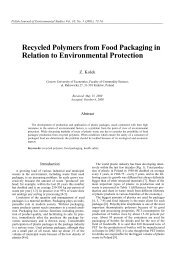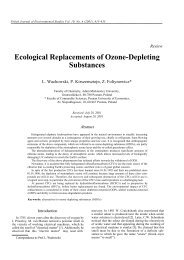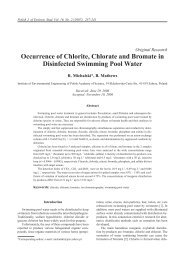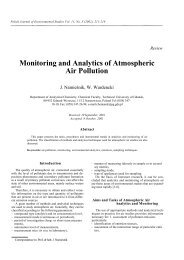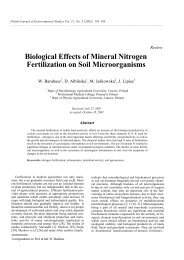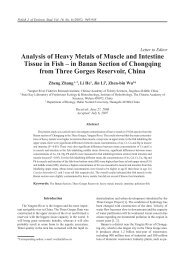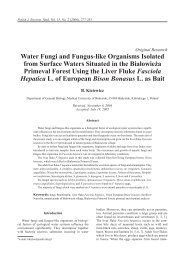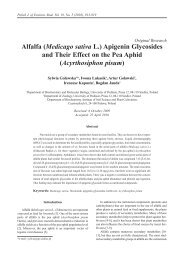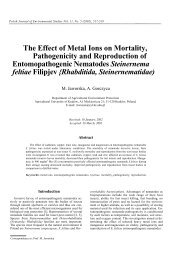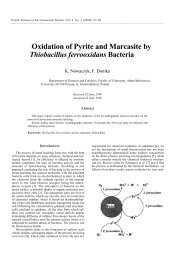Determination of PCBs in Selected Components of a Food Chain by ...
Determination of PCBs in Selected Components of a Food Chain by ...
Determination of PCBs in Selected Components of a Food Chain by ...
You also want an ePaper? Increase the reach of your titles
YUMPU automatically turns print PDFs into web optimized ePapers that Google loves.
572<br />
Waste oils conta<strong>in</strong><strong>in</strong>g <strong>PCBs</strong> have been short listed<br />
as hazardous substances <strong>in</strong> Poland s<strong>in</strong>ce 1993. Available<br />
data have <strong>in</strong>dicated that <strong>in</strong> national power plant <strong>in</strong>stallations<br />
about 1,400 t <strong>of</strong> transformer and capacitor oils are<br />
used [6]. However, well known <strong>in</strong>cidents <strong>in</strong>volv<strong>in</strong>g feed<br />
and food stuff contam<strong>in</strong>ation with organochlor<strong>in</strong>e compounds<br />
have led to an <strong>in</strong>crease <strong>in</strong> the control <strong>of</strong> PCB levels<br />
<strong>in</strong> food and feed products [9]. Legal regulations have<br />
established maximum residue levels <strong>of</strong> seven <strong>in</strong>dicator<br />
isomers. These directives also call for rout<strong>in</strong>e analysis <strong>of</strong><br />
large numbers <strong>of</strong> samples [10]. Therefore, authors can expect<br />
contam<strong>in</strong>ation <strong>of</strong> feeders <strong>by</strong> transformer oils which<br />
still conta<strong>in</strong> <strong>PCBs</strong>. Plant and animal oils are added to fodders<br />
as a carrier for fat-soluble vitam<strong>in</strong>s and also as one<br />
<strong>of</strong> the fundamental component <strong>of</strong> well balanced diet with<br />
prote<strong>in</strong>s and carbohydrates. Other additives like vitam<strong>in</strong>s,<br />
dietary fibers, and microelements <strong>in</strong>clude various <strong>by</strong>products<br />
from nutritional <strong>in</strong>dustry. The fodder contam<strong>in</strong>ation<br />
illustrates the close correlation between the environment<br />
and food production.<br />
An important part <strong>of</strong> any analytical process is sample<br />
preparation, which <strong>in</strong>volves isolation and preconcentration<br />
<strong>of</strong> various analytes <strong>of</strong> <strong>in</strong>terest. Guidel<strong>in</strong>es <strong>of</strong> CEN<br />
(European Committee for Standardization) recommends<br />
different methodologies for extraction, clean up and<br />
analysis [11, 12]. The extraction procedures based on microwave-assisted<br />
extraction (MAE) [13, 14] supercritical<br />
fluid extraction (SFE) [15, 16], and accelerated solvent<br />
extraction (ASE) [17] are widely applied. It is well known<br />
that the clean up step is important before chromatographic<br />
analysis [18]. Additionally, many analytical protocols recommend<br />
clean up procedures. The SPE is a widely used<br />
pre-treatment method which has the property <strong>of</strong> remov<strong>in</strong>g<br />
<strong>in</strong>terferences from a sample matrix. Therefore, this<br />
method based on dual sorbent bed: aryl sulfonic acid and<br />
silica gel (Ar-SO 3<br />
/SiOH) was used for clean<strong>in</strong>g sample<br />
extracts.<br />
The objective <strong>of</strong> the present study was to determ<strong>in</strong>e<br />
the level <strong>of</strong> total <strong>PCBs</strong> <strong>in</strong> fodder and transformer oil samples<br />
collected from different regions <strong>of</strong> Poland. The determ<strong>in</strong>ation<br />
<strong>of</strong> <strong>PCBs</strong> isolated from gett<strong>in</strong>g products, which<br />
are a part <strong>of</strong> human food cha<strong>in</strong> state, is a very important<br />
problem for analytical chemists [19, 20].<br />
Experimental<br />
Materials and Reagents<br />
The fourteen samples <strong>of</strong> transformer oils from the<br />
Factory <strong>of</strong> Transformer and Apparatus Traction <strong>in</strong> Warsaw<br />
and Meat Factory Morl<strong>in</strong>y (Ostróda, Poland) were<br />
collected. The n<strong>in</strong>e samples <strong>of</strong> commercially available<br />
fodder samples have been collected <strong>in</strong> the Polish market.<br />
The n-hexane, methanol and isooctane were purchased<br />
from Fluka (Buchs, Switzerland). The chromatographic<br />
standards <strong>of</strong> PCB (2.4.4’-trichlorobifenyl, IUPAC No. 28;<br />
2,2’,5,5’-tetrachlorobifenyl IUPAC No. 52; 2,2’,4,5,5’-<br />
Ligor T. et al.<br />
pentachlorobifenyl IUPAC No. 101; 2,2’,3,4,4’,5’-heksachlorobifenyl<br />
IUPAC No. 138, 2,2’,3,4,4’,5,5’-heptachlorobifenyl<br />
IUPAC No. 180) were purchased from<br />
Promochem (Wessel, Germany). The technical mixtures<br />
<strong>of</strong> <strong>PCBs</strong>: Aroclor 1242, 1254 and 1260 were obta<strong>in</strong>ed<br />
from Supelco (Bellefonte, PA, USA). The different work<strong>in</strong>g<br />
standard solutions were prepared <strong>by</strong> add<strong>in</strong>g the appropriate<br />
weight primary standard to hexane. The solid phase<br />
cartridges PCB-N with dual sorbents (Ar-SO 3<br />
/SiOH)<br />
1000 mg/3ml were purchased from J.T Baker (S.Witko,<br />
Łódź, Poland). Helium <strong>of</strong> 99.999% purity was purchased<br />
from L<strong>in</strong>de (Gliwice, Poland) and Rtx – 5 (Restek, Bellefonte<br />
PA, USA) column (30 m × 0.25 mm × 0.25 µm).<br />
The ultrasonic bath UM-4 was purchased from Unimasz<br />
(Koszal<strong>in</strong>, Poland).<br />
Apparatus and Analytical Conditions<br />
Chromatographic Investigations<br />
The temperature <strong>of</strong> the GC/MS Turbomass (Perk<strong>in</strong>–<br />
Elmer Co., Norwalk, CT, USA) with split-splitless <strong>in</strong>jector<br />
was 250°C. Splitless time was 0.7 m<strong>in</strong>, split ratio 1:25.<br />
The carrier gas was helium – l<strong>in</strong>ear velocity 35 cm/sec.<br />
Ionisation: EI, 70 eV, MS mode: SIM. Ion source and<br />
transfer l<strong>in</strong>e temperatures: 210 and 200°C, respectively.<br />
The acquisition <strong>of</strong> chromatographic data was performed<br />
<strong>by</strong> Turbomass s<strong>of</strong>tware (Perk<strong>in</strong>–Elmer Co.). Oven temperature<br />
programme for both <strong>in</strong>struments was the follow<strong>in</strong>g:<br />
<strong>in</strong>itial 50°C hold for 1.5 m<strong>in</strong>, then ramp (I) 15°C/m<strong>in</strong><br />
to 150°C (hold 2 m<strong>in</strong>), then ramp (II) 5°C/m<strong>in</strong> to 280°C<br />
(hold 10 m<strong>in</strong>) and ramp (III) 3 o C/m<strong>in</strong>, 295 o C (hold 6<br />
m<strong>in</strong>).<br />
Sample Preparation<br />
A) Fodder samples<br />
ultrasound-assisted solvent extraction with hexane<br />
was used for the preparation <strong>of</strong> fodder. The 10.00 g <strong>of</strong><br />
fodder sample was homogenized with 5 g <strong>of</strong> silica-anhydrous<br />
sodium sulfate (1:1, ww.) mixture loaded <strong>in</strong><br />
a laboratory flask conta<strong>in</strong><strong>in</strong>g 35 ml <strong>of</strong> hexane and extracted<br />
<strong>in</strong> an ultrasonic bath. Extraction was performed<br />
three times for 30 m<strong>in</strong>. Extracts were comb<strong>in</strong>ed, filtered<br />
and evaporated to dryness <strong>in</strong> a vacuum evaporator.<br />
Afterwards, the residue was dissolved <strong>in</strong> a few ml<br />
<strong>of</strong> hexane, transferred <strong>in</strong> 10 ml volumetric flask and<br />
filled up to their volume with hexane. A 250 µl aliquot<br />
<strong>of</strong> this solution was applied to SPE column.<br />
B) The transformer oil samples<br />
The 1.00 g <strong>of</strong> transformer oil was dissolved <strong>in</strong> hexane<br />
and diluted with this solvent to 10 ml <strong>in</strong> a volumetric<br />
flask. The 500 µl <strong>of</strong> this solution was loaded <strong>in</strong> an SPE<br />
column.<br />
C) Clean – up<br />
The solid phase extraction was used for preconcentration<br />
and clean-up <strong>of</strong> both k<strong>in</strong>d <strong>of</strong> extracts. 2 ml <strong>of</strong>



